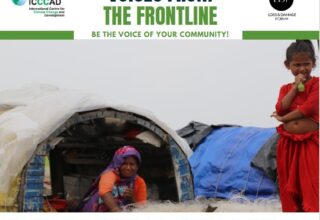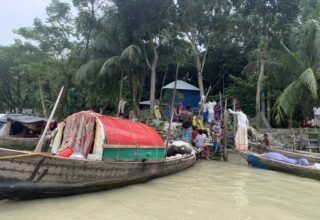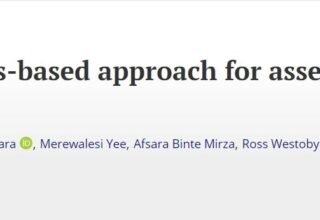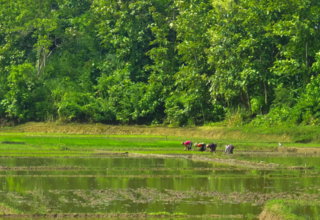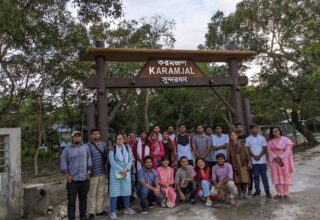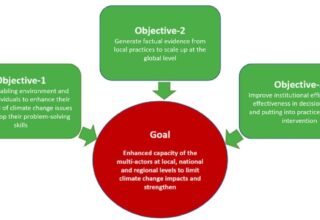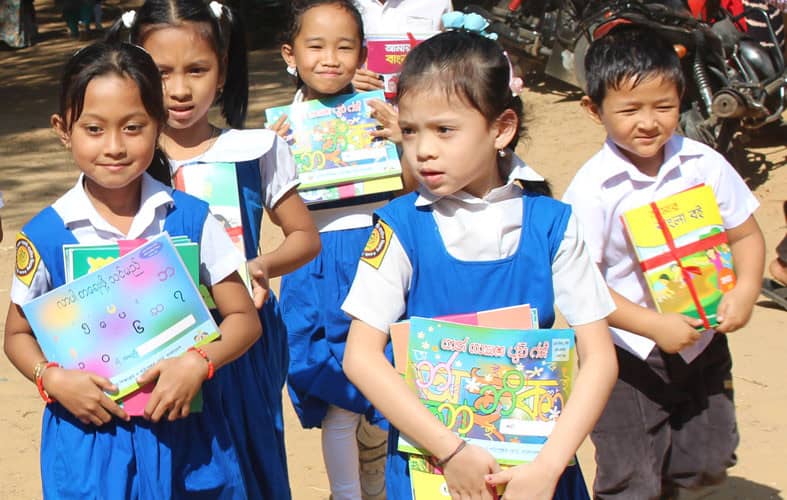
Climate change is a global concern in today’s time, and its impact on the vulnerable population such as women, children, indigenous people, and people with disabilities (PwD) exacerbates their existing social and economic challenges. For instance, the indigenous communities are more susceptible to extreme weather events compared to the non-indigenous groups as many of them live in climate-sensitive areas, and depend much more on natural resources for their survival.
In Bangladesh, around fifty-four different indigenous communities are living across the country. These communities make up 1.8% of the total population of the country, with a higher concentration in the remote areas of Chittagong Hill Tract (CHT).
Our recent study with Cambridge Global Challenges (CGC) in the greater Modhupur and Netrokona region focused on the livelihood and climate resilient practices of Garo and Hajong indigenous communities. The Garo and Hajong communities are two major indigenous communities of Bangladesh, residing in the Central North, and North Eastern territories of Mymensingh, Sherpur, Tangail, and Netrokona region. Agriculture is the prime livelihood for both these indigenous communities, where the Garo community are mostly involved in pineapple, and banana cultivation. On the other hand, the Hajongs cultivate paddy and work as day laborers to earn their living.
Our study finds both these two regions are experiencing extensive heat and arid drought-like conditions, and erratic rainfall, leading to extreme groundwater depletion. The scarcity of groundwater impacts the agriculture and crop production of these regions; undermines animal and livestock productivity; disrupts water sanitation and hygiene (WASH) facilities and women and girls’ menstrual hygiene management, and minimizes fisheries’ yield. Additionally, Garo and Hajong communities’ health and well-being are being impacted by rising infectious diseases, illegal sand extraction, and heat stress conditions. They are also potential victims of systematic discrimination and social, political, and economic exclusion. As a result, it becomes difficult for the Garo and Hajong indigenous communities to receive benefits from public investments, access justice, and participate in the decision-making processes. Therefore, the legacy of inequality and overall exclusion makes the communities more susceptible to the natural disasters and impacts of climate change.
As the formal ownership of the land of the indigenous communities in Bangladesh is yet to be recognized (IWGIA, 2022), many Garos and Hajongs cannot claim the ownership of the land in which they have been living for centuries. Moreover, land acquisition in the name of development and promoting tourism jeopardizes the situation from bad to worse. All these factors limit their agricultural practices, and oftentimes they end up working as day laborers and earning little to ensure their livelihood. However, it is found that indigenous agricultural practices tend to be more sustainable and beneficial for the ecosystem. One of the Garo leaders opines, ‘For centuries our ancestors maintained a bond with nature. As nature takes care of us, we also take care of Her too. But everything is changing now…’
The Shal Forest of Modhupur, which is a vital carbon sink for the area and once the survival toolkit for the Garo communities, is being exploited. Invasion of alien tree species such as Acacia tree (Acacia auriculiformis) is being introduced to replace the Shal (Shorea robusta) trees for earning more profit out of timber as it grows faster. Such a measure is unbalancing the whole natural ecosystem, as the Acacia tree is turning out to be unsuitable for the local topography; being poisonous for birds and insects; impacting the overall ecosystem, and leading to health issues such as itchiness for the skin.
However, Garo and Hajong communities’ indigenous and traditional knowledge helps them to safeguard nature and benefit their own wellbeing through practicing ethnomedicine; developing early warning techniques; practicing crop rotation, and homestead gardening. Their wisdom maintains balance and promotes respect and harmony between humans and the natural world, especially regarding resource utilization. These traditional techniques strive to have a little environmental impact and promote self-sustaining ecosystems and biodiversity.
Since, the majority of the Garo and Hajong communities reside in remote areas, without proper access to smooth internet services, well-built roads, and easy transportation services, modernized educational institutions are at a higher risk to be eliminated from the labor force participation and have minimal contribution to the country’s GDP. Hence, their basic rights and participation in decision-making activities should be ensured, through proper investment and capacity building.
As the intensity and frequency of extreme weather events are anticipated to rise in the future, it is also crucial to establish a repository that will capture the cultural and indigenous values of Garo and Hajong communities, so that they can help their future generations to adapt to the impacts of climate change. Their traditional knowledge relies on nature-based solutions (NbS) which are passed down through generations, and it can effectively contribute to local, national, and global adaptation methods. Their time-tested techniques should drive policy decisions and be incorporated into adaptation frameworks alongside indigenous peoples’ rights mandates.
In this regard, the eight criteria of nature-based solutions could be used to increase the accountability and participation of the Garo and Hajong communities. For instance, criteria five, six, and eight specifically mention upholding the rights of Indigenous Peoples to Free Prior and Informed Consent (FPIC); respecting their rights and access to resources, and ensuring full participation in the governance process. While, the eight principles of Locally-led Adaptation can be utilized for making the indigenous communities better decision makers by investing in local institutions for their capacity building; disseminating information about climate risks in local languages; collaboratively working with donors, INGOs, NGOs, private sectors, academicians, schools and colleges. Besides, recognizing the urgency of incorporating traditional and indigenous knowledge with the scientific tools and technologies will also be an important step to increasing the participation of indigenous communities to become future climate champions. All these measures can certainly and eventually help the indigenous communities to raise their voices, create an exposure, and ensure their rights, justice, and equity.
Originally this article was published on August 01, 2022 at Dhaka Tribune.
Savio Rousseau Rozario is currently working at the International Centre for Climate Change and Development (ICCCAD) as a Junior Research Officer. He can `be reached at savio.rozario@icccad.org
Afsara Binte Mirza is working as a Junior Research Officer at ICCCAD. She can be reached at afsara.mirza@icccad.org
Fatema Akhter is working as a Junior Research Officer at ICCCAD. She can be reached at fatema.akhter@icccad.org

